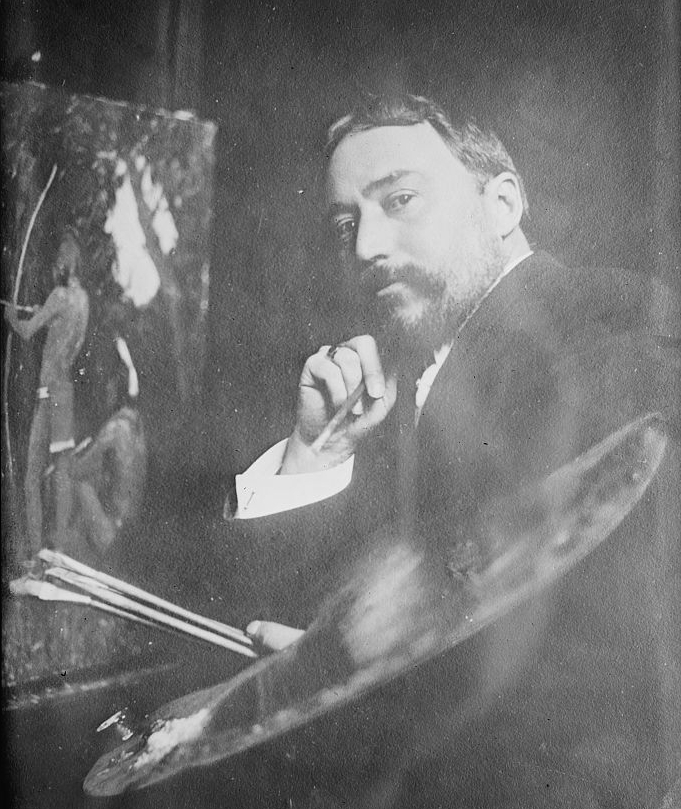- E. Irving Couse
Infobox Artist
bgcolour = #6495ED
name = E. Irving Couse

imagesize =
caption = Eanger Irving Couse
birthname =
birthdate = 1866
location = Saginaw
deathdate = 1936
deathplace =
nationality = American
field =Painting
training =National Academy of Design , New York
movement =
works =
patrons =
influenced by =
influenced =
awards =Eanger Irving Couse (1866-1936) was an artist and founding member of the Taos artists colony in
Taos, New Mexico . Couse was born in Saginaw,Michigan , where he first started drawing theChippewa Indians who lived nearby. Couse attended the Art Institute of Chicago, and theNational Academy of Design , New York. He left forParis to study at thecole des BeauxArts andAcadmie Julian under Bouguereau. He lived inFrance 10 years, where he painted charming scenes of theNormandy coast. After his return to America he devoted himself to depicting the life and habits of the Taos Indians, a pueblo tribe inNew Mexico . He reveals the poetical and philosophical rather than the savage and warlike side of the Indians, and his skillfully executed pictures are full of sentiment. Among those in public galleries are "Elkfoot" (National Gallery, Washington); "The Forest Camp" (Brooklyn Museum); "The Tom-Tom Maker" (Lotos Club, New York); "Medicine Fires" (Montclair Gallery, New Jersey); "Shapanagons, a Chippewa Chief" (Detroit Museum). He was elected to the National Academy of design in 1911.New International Encyclopedia In 1912 when the Taos Society of Artists was formed, Couse was elected its first President.Early works
In 1899, Course exhibited three paintings at the
Boston Art Club : "A Cayuse Indian" (oil), "Maternity" (oil), and "Yakima Encampment" (oil). At the time of this Exhibition, Course listed his current address as the Van Dyck Studios, 939 8th Avenue, NYC.Later works
* "Mending the War Bonnet"
* "Making Pottery" (awarded the Carnegie prize)
* "Rushing Water" (1912)
* "Twilight, Taos Pueblo" (1913)During his career, Couse exhibited widely and won numerous awards at: the
Paris Salon , theArt Institute of Chicago , the National Academy of Design (Altman prize, 1916), theSalmagundi Club (Isidor prize, 1917), and was awarded the Lippincott prize from thePennsylvania Academy of Fine Arts (1921). He received awards from the American Exposition, Buffalo, theBoston Art Club , the Corcoran Gallery and the Panama Pacific International Exposition in San Francisco (silver medal, 1915). His works are held in many museums in the United States and around the world.Couse died in Taos, New Mexico in 1936.
Asked how to say his name, he told "The
Literary Digest " that it rhymed with "house". (Charles Earle Funk, "What's the Name, Please?", Funk & Wagnalls, 1936.)External links
* [http://www.bostonartclub.com Boston Art Club: official site]
* [http://www.ou.edu/artcollections/collections/thams/couse_ambush.html Painting "In Ambush"]
* [http://www.ou.edu/artcollections/collections/thams/couse_fish.html Painting "The Housewife Looking at the Fisherman's Catch"]
* [http://www.ou.edu/artcollections/collections/thams/couse_love.html Painting "Love Song (aka Moonlight)"]
* [http://www.ou.edu/artcollections/collections/fleischaker/couse-bird_jar.html Painting "The Bird Jar"]
* [http://www.ou.edu/artcollections/collections/american/couse_medicine.html Painting "The Medicine Maker"]
* [http://www.ou.edu/fjjma/home/main/fall_2008/southwestern/couse.html Painting "Pottery Vendor" (1916)]
Wikimedia Foundation. 2010.
